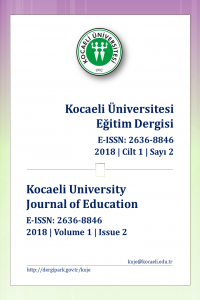İki Farklı Düzeltici Geri Bildirim Türünün İngilizce Öğretiminde Öğrencilerin Yazma Becerileri Üzerindeki Etkisi
Öz
Bu çalışma, Kocaeli Üniversitesi
İngilizce hazırlık biriminde bir sınıfta öğrencilerden iki farklı grup
oluşturularak yazma becerilerini geliştirmede öğrenciye verilen iki farklı
düzeltici geri bildirim etkisinin kıyaslamasını hedeflemektedir. Öğrencilerin,
yazma becerilerinin gelişimini daha iyi takip edebilmek adına, veri toplama
aracı olarak süreç odaklı yazma metodu kullanılmıştır. Bu çalışmada, metodun
basamakları Taslak 1, Taslak 2, Taslak 3 şeklindedir. Öğrencilerin, bu taslaklarına
iki farklı düzeltici geribildirim verilmiştir. Geri bildirimlerden biri direkt
düzeltmeyi esas alırken; diğeri, öğrencilerin kendilerine verilen Düzeltme
Tablosu Sembollerinden yola çıkarak, yanlışları üzerinde düşünerek dolaylı
yoldan bulmalarını amaçlamıştır. Standart bir sınıfta, haftalık İngilizce yazma
becerisini geliştirme dersi toplam 4
saattir. Araştırma verileri 6 hafta boyunca haftada 4 saat olan yazma
becerilerini geliştirme dersi olan 30 yetişkin öğrencinin hem ders içi hem ders
dışı yazdığı paragraflar aracılığıyla toplanmıştır. Verilen konular, kullanılan
kitaptaki konular ile paraleldir. Örnek yapılar ve konu ile ilintili kelime
çalışmaları ders saati içerisinde yapılmıştır. Öğrencilerin ilk taslaklarına
çeşitli düzeltici geribildirimler uygulandıktan sonra kendilerine düzeltilmesi
için verilen ikinci taslaklarını eposta olarak göndermişlerdir ve elde edilen
veriler her iki grupta da ikinci taslaklarında hata oranının azaldığını
göstermiştir. Bir hafta arayla hem kontrol hem deney grubu ile üçüncü taslak
oluşturmak için benzer bir çalışma yapılmıştır. Elde edilen verilerde
öğrencilerin hatasız cümle oranının üçüncü taslaklarında, ikinci taslaklarına
göre azaldığı gözlemlenmiştir. İki farklı düzeltici geribildirimden, dolaylı
geribildirimin daha etkili olduğu saptanmıştır.
Anahtar Kelimeler
Doğrudan geribildirim Dolaylı geribildirim Geribildirim Türk öğrenciler Yazma becerisi
Kaynakça
- Egi,T.(2010). Uptake, Modified Output, and Learner Perceptions of Recasts: Learner Responses as Language Awareness. The Modern Language Journal 94, 1-21
- Ferris, D. R. (1999). The case for grammar correction in L2 writing classes. A response to Truscott (1996). Journal of Second Language Writing, 8, 1–10.
- Kepner, C. G. (1991). An experiment in the relationship of types of written feedback to the development of second-language writing skills. Modern Language Journal, 75, 305–313.
- Larsen-Freeman, D. (2000). Techniques and principals in language teaching. (2nd ed.). Oxford: Oxford University Press.
- Lightbown, P., & Spada, N. M. (1999). How languages are learned. Oxford: Oxford University Press.
- Loewen, S., & Philp, J. (2006). Recasts in the adult English L2 classroom: Characteristics, explicitness, an effectiveness. Modern Language Journal, 90, 536-556
- Long, M. H. (1996). The role of the linguistic environment in second language acquisition. In W. C. Ritchie & T.
- Lyster, R. (1998a). Recasts, repetition, and ambiguity in L2 classroom discourse. Studies in Second Language Acquisition, 20, 51-81.
- Lyster, R. (1998b). Negotiation of form, recasts, and explicit correction in relation to error type and learner repair I immersion classrooms. Language Learning, 48.
- Lyster, R. (2002). Negotiation in immersion teacher-student interaction. International Journal of Educational Research, 37, 237-253.
Öz
The present study aims to compare the effectiveness of
two different types of corrective feedback: implicit and explicit through
learners’ process writing. Process writing is a method which includes drafts to
observe students’ improvement with the help of the following drafts. In this
study, the sequence of drafts is like that: D1, D2 and D3. The research is conducted with 30 Turkish
elementary level students from the preparatory school at Kocaeli University.
The writing subjects are chosen in harmony with the subjects in the coursebook This treatment lasts 4 hours in school and
continues for students after school for 6 weeks. Students were expected to
submit their second draft via email. The students are evenly divided into two
groups. While the students in control group receive the correction on their
draft 1 and 2 explicitly such as direct correction; the students in the
treatment group are expected to infer their errors on their own from the
symbols in the correction symbols chart given them beforehand. The data
obtained from the second drafts given for the correction to the students after
applying various corrective feedback to the students' initial drafts show that
the error rate decreases in the second drafts in both groups. A similar
treatment standing as Draft 3 is conducted both with the control and
experimental groups after a week later. The data obtained show that there is a
decrease in the error free clauses rate in the third draft when compared to the
students’ second draft. Out of two different types of corrective feedback, the
implicit feedback is slightly more effective.
Anahtar Kelimeler
Corrective feedback Explicit feedback Implicit corrective feedback Turkish students Writing skills
Kaynakça
- Egi,T.(2010). Uptake, Modified Output, and Learner Perceptions of Recasts: Learner Responses as Language Awareness. The Modern Language Journal 94, 1-21
- Ferris, D. R. (1999). The case for grammar correction in L2 writing classes. A response to Truscott (1996). Journal of Second Language Writing, 8, 1–10.
- Kepner, C. G. (1991). An experiment in the relationship of types of written feedback to the development of second-language writing skills. Modern Language Journal, 75, 305–313.
- Larsen-Freeman, D. (2000). Techniques and principals in language teaching. (2nd ed.). Oxford: Oxford University Press.
- Lightbown, P., & Spada, N. M. (1999). How languages are learned. Oxford: Oxford University Press.
- Loewen, S., & Philp, J. (2006). Recasts in the adult English L2 classroom: Characteristics, explicitness, an effectiveness. Modern Language Journal, 90, 536-556
- Long, M. H. (1996). The role of the linguistic environment in second language acquisition. In W. C. Ritchie & T.
- Lyster, R. (1998a). Recasts, repetition, and ambiguity in L2 classroom discourse. Studies in Second Language Acquisition, 20, 51-81.
- Lyster, R. (1998b). Negotiation of form, recasts, and explicit correction in relation to error type and learner repair I immersion classrooms. Language Learning, 48.
- Lyster, R. (2002). Negotiation in immersion teacher-student interaction. International Journal of Educational Research, 37, 237-253.
Ayrıntılar
| Birincil Dil | İngilizce |
|---|---|
| Konular | Eğitim Üzerine Çalışmalar |
| Bölüm | Araştırma Makaleleri |
| Yazarlar | |
| Yayımlanma Tarihi | 25 Aralık 2018 |
| Gönderilme Tarihi | 18 Kasım 2018 |
| Yayımlandığı Sayı | Yıl 2018 Cilt: 1 Sayı: 2 |


